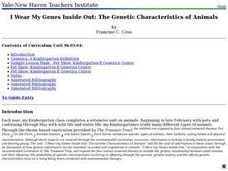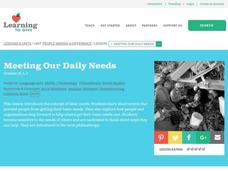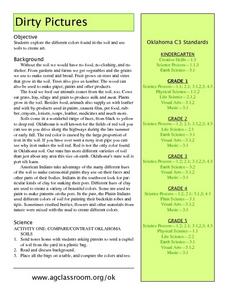Curated OER
Building a Butterfly Garden
Students plant a garden which will become the habitat for butterflies as they go through their life cycle. In this life cycle lesson, students grow plants that attract butterflies and feed caterpillars in order to observe the entire...
Curated OER
First sentence completion: 11
In this sentence completion worksheet, students fill in the blank in the first sentence based on what the second sentence is saying. Students complete 10 multiple choice question.
Curated OER
Saving Big Cats from Extinction
Students explore extinction. In this biology and environmental science activity, students define extinction, identify what living things need to survive, and create a persuasive poster about "saving the big cats" using a desktop...
Curated OER
Making Corn-Husk Dolls
Second graders create corn husk dolls. In this pioneers lesson, 2nd graders use corn husks, thread, scissors and simple cloth to create corn husk dolls. They discuss how the pioneer children used these toys, this discussion is intended...
Curated OER
Simple Past Tense-Beginners
In this simple past tense worksheet, students read about forming past tense, then put verbs in sentences into past tense and rewrite sentences in past tense.
Curated OER
Past Simple or Past Continuous
In this past simple and past continuous worksheet, students put the verbs in the brackets in sentences in the correct tense. Students complete 2 activities.
Curated OER
A Seed Dispersal Investigation
Students investigate the function and purpose of seed dispersal. In this garden lesson, students examine the importance of wind in the plant cycle. Students construct a flying seed model from an attached design and discuss if it can be...
Curated OER
Feathers for Lunch Lesson Plan
Learners discover different types of birds and the habitats in which the dwell. In this bird lesson, students read Feathers for Lunch, discuss bird facts, and build a bird habitat.
Curated OER
Plant Parts
Students recognize the parts of the plant and the function it provides.In this plant parts lesson, students participate in three activities relating to plant parts and properties.
Curated OER
Cause and Effect
Students examine examples of cause and effect. They participate as a teacher engages them in activities with an egg.
Curated OER
Seeds, Miraculous Seeds
Students investigate the growth of seeds. In this agricultural lesson, students dissect a bean and corn seed and identify the parts of the seed. Students observe the development of a pinto bean seed and record observations on the...
Curated OER
I Wear My Genes Inside Out: The Genetic Characteristics of Animals
Students create mixed breed dogs using paper illustrations of various breeds. They label dogs created by students using the Genetics Center and discuss the aspects of genetics that affect the outcome of the various projects.
Scholastic
A House for Hermit Crab
Engage young marine biologists in a reading of Eric Carle's A House for Hermit Crab with a fun hands-on activity. Given a set of clipart images of the different aquatic animals that appear in the book, children identify each one during a...
Curated OER
People Making a Difference
Students research the idea of basic needs, study philanthropists in their community, and think about ways to help others receive basic needs. For this needs and philanthropy lesson, students brainstorm about basic needs. Students use...
Curated OER
Tsunami
Students discuss the tsunami disaster. They read about the tsunami disaster in newspapers, magazines and web sites. They write a paragraph explaining the tsunami disaster.
Curated OER
Dirty Pictures
Students investigate how food, clothing and shelter come from soil after they examine soil from their own backyards. They map soils on the color wheel before making glue and soil pictures and tie-dying T-shirts in red soil.
Curated OER
Yoruba Naming Ceremony
Students, after identifying the history of their own names, write a sentence describing how their name is similar or different to Yoruba studenT names.
Curated OER
Measure Your Body
Students measure their bodies. In this math lesson plan, students record their height and weight. Students measure themselves in six months and observe any changes.
Curated OER
PIZZA PARTS
Students will measure the ingredients to make pizza dough and determine basic fractions to cut pizza.Discuss where the different ingredients come from as you follow the instructions below to put the pizza together (flour from wheat,...
Curated OER
Rice (Gohan) Observations
Second graders investigate rice or gohan as it's called in Japan in a couple of experiments. They tally the results.
Curated OER
Minnesota-China Connections: Chinese Flavors
Students discuss the foods which are typical of a Chinese diet. They find recipes and observe and sample various Chinese foods. They record their opinions about what they taste and experience in a journal entry.
Curated OER
Sounds Great
Students examine the types of sounds sculptures make. They create their own sculpture that make sound using everyday materials.
Curated OER
Japanese Folktales for Children
Students study Japanese folkart traditions and culture through storytelling, class discussions, and a creative project. The project involves students creating drawings of a pre-selected folktale and putting them together in a class book.

























